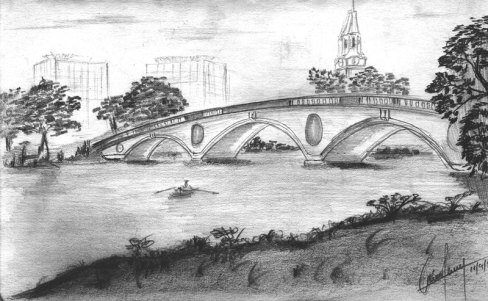Many of us might have indulged in field sketching in our lives but may not be exactly familiar with this term. It was new to me at least and so I would like to define it first. A field sketch is a free-hand drawing of a map or a picture of a landscape, a house, and a route of travel or just about any area for which a map is not available or the existing maps are not adequate. It is not exactly a reproduction of a scene and is only meant to highlight the important features.
In academics, it’s a widely geographical tool used to cater to a variety of purposes. Field sketching helps in recording observations and measurements made during fieldwork or during learning activities outside the classroom that focus on geographical or topographical areas. A field sketch gives a summary of key structural and geological features, helps in analyzing photographs which are taken in the field, and quite importantly acts as a tool to complement visual memory.
Now how to proceed about drawing a field sketch? Firstly, you do not have to be an artist to make a field sketch and all you actually need to do is draw a simple outline diagram. Sketches are judged on their ability to convey information and not their artistic merit. Secondly, it shouldn’t take more than a few minutes to complete a field sketch but your work must be neat and tidy. Thirdly, all that you actually need is a soft pencil and a blank sheet of paper.
To begin with a landscape field sketch, one must clearly divide the scene into three parts: foreground, middle distance and background. It is crucial that the field sketch displays the relative position of different items correctly and is not cluttered. This field sketch must also have a scale and the different features should be clearly labelled. If sketching an object, person or animal, divide the subject into quarters by drawing a cross through the center of the page and using it to center the drawing. Field sketches can be as detailed or as light as one wants them to be.
The usage of field sketches is however not restricted to geography classes or field work in that subject. Wildlife researchers are known to use these to capture the environment and the animals without disturbing them with photography. Architects and landscape artists use them to illustrate the terrain and create their rendition of future plans on that terrain. Artists can also use field sketches to capture certain features of a landscape that they may later use in their paintings. Most of us would also have drawn a rough field sketch to help someone with a route of travel, highlighting in it the key landmarks, traffic signals, shops etc. We have also used sketches to chart out the layout of a house, a mall, a shop, a building, a hotel and what not.
Field sketching is an amazing tool that can provide with the key information about any place. It helps in detailing out everything of significance, everything that one needs to know. Typical sketch components include the perspective (North, South, East, West: side, top, oblique view), scale, location and date of sketch and key feature labels. This provides all necessary information that a third person can require about a place or an object. Field sketching is also a wonderful way to remember details about what a person has sketched. Just as one learns about something when required to write about it, so does the visual world come clearer if one draws a picture or diagram. The visual details stay with a person for a really long time. A sketch can also be used to document how a place might have changed over a period of time. This can help in considering the causes and consequences of those changes.
A field sketch can be complimented by photography as well. Photos can be used to add details to the sketch later. But with the advancements in photography and videography technology, people are increasingly replacing field sketches with photographs. While the camera can gather lots of data, drawing a sketch puts a lot of data into your brain instead of a memory card. One observes the minutest of details while sketching, which tend to get ignored in a photograph. Thus sketching is a way of thinking and a way of learning.
There can never quite be a full conversion from field sketching to photography due to the human touch involved in holding a sketch pad and pencil and peacefully drawing out a landscape, or a rough map to help your friend reach a place, or to explain the layout of your new house to your family. Sometimes it’s better to sketch than to shoot.
Even though one need not be an artist to sketch, field sketching sure is an art that needs to be perpetuated through the era of the camera.

Leave a Reply